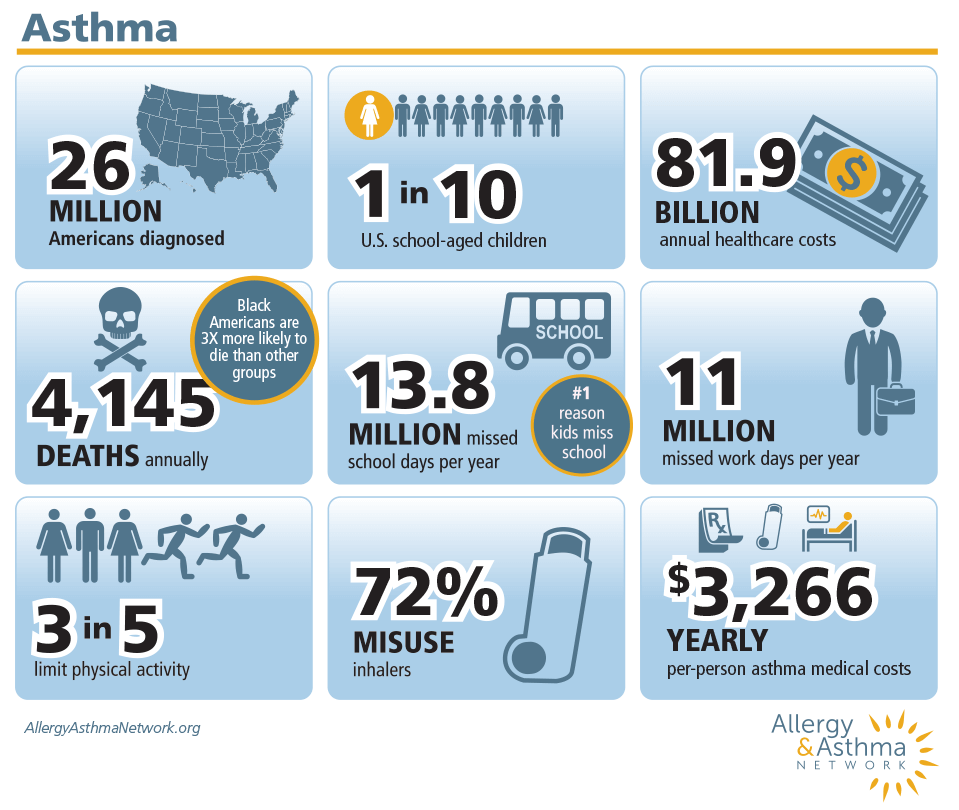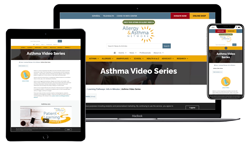Asthma Statistics
- Home
- |
- What is Asthma?
- |
- Asthma Statistics

Asthma prevalence
Asthma occurs in people of all ages, ethnicities, and genders, but there are some populations where it is more common:
- 26+ million people live with asthma in the United States 9
- Asthma affects 8% of adults and 6.5% of children 10
- Asthma affects more boys than girls in childhood 9
- Asthma is more common in adult women than adult men 9
- Asthma is more common in Blacks, American Indians or Alaskan Natives, and people of multiple ethnicities 9
Asthma prevalence by race and ethnicity
- Multiple races 11.5% 9
- Blacks 10.8% 9
- American Indians/Alaskan Natives 10.8 % 9
- Whites 7.6% 9
- Hispanics 6.7% 9
- Asians 3.5% 9
Definition of asthma
Asthma is a chronic, or long-term, condition that intermittently inflames and narrows the airways in the lungs. The inflammation makes the airways swell. Asthma causes periods of wheezing, chest tightness, shortness of breath, and coughing. People who have asthma may experience symptoms that range from mild to severe and that may happen rarely or every day. When symptoms get worse, it is called an asthma attack. Asthma affects people of all ages and often starts during childhood. Defining “what is asthma” is the first step towards management.
The goal of asthma management is to achieve control with an asthma action plan. An asthma action plan may include monitoring, avoiding triggers, and using medicines. 1
Causes of asthma
The exact cause of asthma is unknown, though it may be a combination of factors some of which include:
- Genetics 2
- Viral respiratory infections in early childhood 3, 4
- Environmental exposures, such as children born to mothers who smoked during pregnancy, and children exposed to indoor allergens and outdoor pollution, 5,6
Asthma triggers
There are multiple environmental and behavioral factors which can trigger asthma symptoms with some of the most frequently reported triggers including:
Asthma treatment
Treatment of asthma focuses on diagnosis, treatment control symptoms, and routine follow-up to ensure adequate control, as well as the provider and the patient working together to create an “asthma action plan”. There are two primary focuses of treatment 8:
- Reduce impairment – this includes reducing the severity and frequency of symptoms which will reduce the impact on daily function
- Reduce risk – this is done through reducing the risk of future complications from asthma including asthma attacks and impacts on lung function.
Disparities in asthma
In addition to the disparities seen in asthma between gender, age, and ethnicity, there are also disparities based upon household income:
- Asthma affects 11% of people living in poverty 9
- As income increases, asthma prevalence decreases, with those in the highest income bracket having the lowest rates of asthma at 6.7% 9
Asthma morbidity & mortality
There are over 25 million people living with asthma in the United States, including:
Of those who have ever had a diagnosis of asthma, many reported at least one or more asthma attack including:
In 2020 4,145 people died from asthma 11:
- The asthma death rate is highest among people over the age of 65 11
- Adult females have a higher rate of death than males 11
- Among children, boys are more likely to die than girls 11
- Blacks area nearly three times more likely to die from asthma than all other racial or ethnic groups 11
School children & asthma
Asthma is one of the leading chronic illnesses of childhood and adolescence 12
- One in 10 school-aged children have asthma 12
- Over 13 million school days are missed annually due to asthma 15
- Children with asthma miss 2.3 days more of school than their peers with a per-child cost of $207 13
- Over half of school children with asthma missed as least one day of school in the previous year due asthma 13
- Children who miss school in the previous year due to asthma are more likely to be poor and children of color 13
- 5.5% of children with an asthma-related school absence were unable to see a primary care doctor due to cost 13
The economic burden of asthma
Asthma is an extremely expensive disease, costing the United States $81.9 billion annually 16
The annual per-person medical costs for asthma are $3,266 annually 16. These costs break down as follows:
- $1,830 for medications 16
- $640 for office visits 16
- $529 for hospitalizations 16
- $176 for outpatient hospital visits 16
- $105 for care in the emergency department 16
Asthma-related deaths cost $29 billion annually 16
References (last updated 1/12/2023)
- https://www.nhlbi.nih.gov/health-topics/asthma/
- https://www.sciencedirect.com/science/article/abs/pii/S0091674915001153
- https://www.atsjournals.org/doi/full/10.1164/ajrccm.161.5.9906076
- https://www.sciencedirect.com/science/article/abs/pii/S0091674905015241
- https://www.embopress.org/doi/full/10.15252/msb.20156520
- https://www.sciencedirect.com/science/article/abs/pii/S1438463915001182
- https://www.ncbi.nlm.nih.gov/pmc/articles/PMC5349698/
- https://www.nhlbi.nih.gov/files/docs/guidelines/asthma_qrg.pdf
- https://www.cdc.gov/asthma/most_recent_national_asthma_data.htm
- https://www.cdc.gov/nchs/fastats/asthma.htm
- https://www.cdc.gov/asthma/asthma_stats/asthma_underlying_death.html
- https://www.cdc.gov/healthyschools/asthma/index.htm
- https://www.ncbi.nlm.nih.gov/pmc/articles/PMC4914465/
- https://minorityhealth.hhs.gov/omh/browse.aspx?lvl=4&lvlid=60
- https://www.cdc.gov/asthma/asthma_stats/missing_days.htm
- https://www.thoracic.org/about/newsroom/press-releases/resources/asthma-costs-in-us.pdf

Quick 3-5 minute videos on asthma, allergies, and related conditions.
Are there other conditions that may look like asthma or complicate asthma?
There are other types of respiratory conditions that are different than asthma. The symptoms, diagnosis and treatment can vary depending upon the condition. Here are some of them.
